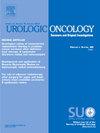Benign ureteroenteric anastomotic stricture predictors in radical cystectomy patients: A critical analysis focusing on the nutritional risk index and postoperative urinary tract infection
IF 2.3
3区 医学
Q3 ONCOLOGY
Urologic Oncology-seminars and Original Investigations
Pub Date : 2025-08-12
DOI:10.1016/j.urolonc.2025.07.011
引用次数: 0
Abstract
Objective
To investigate preoperative, surgery-related, and postoperative parameters in terms of their ability to predict benign ureteroenteric anastomotic strictures (UAS) after radical cystectomy (RC).
Methods
The clinical data of patients who underwent RC between January 2016 and December 2022 at a tertiary referral center were retrospectively collected. A total of 79 RC patients who met the inclusion criteria were included in the study. The patients were divided into 2 groups during postoperative follow-up: those who developed UAS and those who did not develop UAS.
Results
UAS developed in 20 (25.3%) patients after RC, while 59 (74.7%) patients did not develop UAS. The median follow-up times of the UAS and non-UAS groups were 38 (interquartile range: 12–69) and 35 (12–64) months, respectively (P = 0.242). The mean Nutritional Risk Index (NRI) scores of the UAS and non-UAS groups were 79±9.8 and 89.8 ± 13.8, respectively (P = 0.002). Multivariate analysis identified several independent predictors of UAS. The presence of an American Society of Anesthesiologists (ASA) IV classification (P < 0.001), preoperative hydronephrosis (P = 0.039), NRI score (P = 0.019), and postoperative urinary tract infection (UTI) (P = 0.016) were significant predictors of postoperative UAS. The optimal cut-off value of the NRI was determined to be 83.05, with an area under the curve of 0.731 at this cut-off.
Conclusions
Postoperative UTI, presence of ASA IV, and preoperative hydronephrosis were identified as independent risk factors for UAS development after RC. The NRI score was lower in patients with UAS than in those without UAS. Poor nutritional status in patients undergoing RC may contribute to an increased risk of UAS development.
根治性膀胱切除术患者的良性输尿管肠吻合口狭窄预测因素:营养风险指数和术后尿路感染的关键分析。
目的:探讨根治性膀胱切除术(RC)后,术前、手术及术后相关参数预测良性输尿管肠吻合口狭窄(UAS)的能力。方法:回顾性收集2016年1月至2022年12月在某三级转诊中心接受RC的患者的临床资料。符合纳入标准的总共79例RC患者被纳入研究。术后随访时将患者分为两组:发生UAS组和未发生UAS组。结果:20例(25.3%)患者在RC后发生UAS, 59例(74.7%)患者未发生UAS。UAS组和非UAS组的中位随访时间分别为38个月(四分位数间距:12-69)和35个月(12-64)个月(P = 0.242)。UAS组和非UAS组营养风险指数(NRI)平均评分分别为79±9.8分和89.8±13.8分(P = 0.002)。多变量分析确定了几个独立的预测因子。美国麻醉医师协会(ASA) IV分类(P < 0.001)、术前肾积水(P = 0.039)、NRI评分(P = 0.019)和术后尿路感染(P = 0.016)是术后UAS的重要预测因素。确定NRI的最佳截断值为83.05,该截断点曲线下面积为0.731。结论:术后尿路感染、ASA IV的存在和术前肾积水被认为是术后UAS发展的独立危险因素。UAS患者的NRI评分低于无UAS患者。接受RC的患者营养状况不佳可能会增加UAS发展的风险。
本文章由计算机程序翻译,如有差异,请以英文原文为准。
求助全文
约1分钟内获得全文
求助全文
来源期刊
CiteScore
4.80
自引率
3.70%
发文量
297
审稿时长
7.6 weeks
期刊介绍:
Urologic Oncology: Seminars and Original Investigations is the official journal of the Society of Urologic Oncology. The journal publishes practical, timely, and relevant clinical and basic science research articles which address any aspect of urologic oncology. Each issue comprises original research, news and topics, survey articles providing short commentaries on other important articles in the urologic oncology literature, and reviews including an in-depth Seminar examining a specific clinical dilemma. The journal periodically publishes supplement issues devoted to areas of current interest to the urologic oncology community. Articles published are of interest to researchers and the clinicians involved in the practice of urologic oncology including urologists, oncologists, and radiologists.

 求助内容:
求助内容: 应助结果提醒方式:
应助结果提醒方式:


